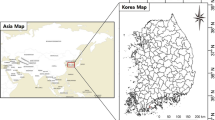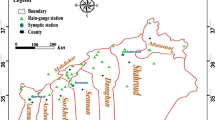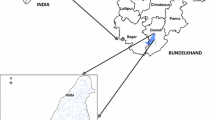Abstract
Taiwan is located in Western Pacific and receives approximate 2,500 mm rainfall per year. Suffered from inadequate water supply during prolonged and severe droughts, assessing drought risk becomes one of the key tasks of water-resources planning and management in Taiwan. Well-prepared drought mitigation measures require assimilation of physical environment of droughts and human socioeconomic factors. An index-based approach is presented in this study to evaluate drought risk at municipal scale in Taiwan for current status (2008) as well as future scenarios (2021). A multiplicative formula links drought hazard (frequency, duration, and severity of droughts), drought exposure (water use), and drought vulnerability (unreliable water supply) to determine drought risk. This approach quantifies the spatial distribution of drought risk and is able to deal with future changes of water use and water-supply source and to examine their influences on drought risk assessments. The results reveal that the regions that are at great risk in the future are those regions already threaten by drought currently. Changes of future water use and water-supply source would not significantly alter spatial distribution of drought risk and ranking order among regions. These results present a basis for future water-resources planning and economic developments for each municipal region.








Similar content being viewed by others
References
Alcamo J, Acosta-Michlik L, Carius A, Eierdanz F, Klein R, Krömker D, Tänzler D (2008) A new approach to quantifying and comparing vulnerability to drought. Reg Environ Change 8(4):137–149
Below R, Grove-Kopec E, Dilley M (2007) Documenting drought-related disasters: a global reassessment. J Environ Dev 16(3):328–344
Hall J, Murphy C (2010) Vulnerability analysis of future public water supply under changing climate conditions: a case study of the Moy catchment, Western Ireland. Water Resour Manag≠ 24(13):3527–3545
Hall JW, Sayers PB, Dawson RJ (2005) National-scale assessment of current and future flood risk in England and Wales. Nat Hazards 36(1–2):147–164
Hamouda MA, El-Din MMN, Moursy FI (2009) Vulnerability assessment of water resources systems in the Eastern Nile Basin. Water Resour Manage 20(13):2697–2725
He B, Lu AF, Wu JJ, Zhao L, Liu M (2011) Drought hazard assessment and spatial characteristics analysis in China. J Geogr Sci 21(2):235–249
Joe H (1997) Multivariate models and dependence concepts. Chapman and Hall, New York
Kao SC, Govindaraju RS (2010) A copula-based joint deficit index for droughts. J Hydrol 380:121–134
Kron W (2005) Flood risk = hazard · values · vulnerability. Water Int 30(1):58–68
Kulshreshtha SN (1998) A global outlook for water resources to the year 2025. Water Resour Manage 12(3):167–184
Liu CL, Zhang Q, Singh VP, Cui Y (2011) Copula-based evaluations of drought variations in Guangdong, South China. Nat Hazards 59(3):1533–1546
McKee TB, Doesken NJ, Kleist J (1993) The relationship of drought frequency and duration to time scales. In: Proceedings of the 8th conference on applied climatology, pp 179–184
Meyer V, Scheuer S, Haase D (2009) A multicriteria approach for flood risk mapping exemplified at the Mulde river, Germany. Nat Hazards 48(1):17–39
Mirabbasi R, Fakheri-Fard A, Dinpashoh Y (2012) Bivariate drought frequency analysis using the copula method. Theor Appl Climatol 108(1–2):191–206
Mirakbari M, Ganji A, Fallah SR (2010) Regional bivariate frequency analysis of meteorological droughts. J Hydrol Eng 15(12):985–1000
Mishra KM, Singh VP (2011) Drought modeling—a review. J Hydrol 403:157–175
Nelsen RB (1999) An introduction to copulas. Springer, New York
Odeh D (2002) Natural hazard vulnerability assessment for statewide mitigation planning in Rhode Island. Nat Hazard Rev 4(3):177–187
Pandey RP, Pandey A, Galkate RV, Byun HR, Mal BC (2010) Integrating hydro-meteorological and physiographic factors for assessment of vulnerability to drought. Water Resour Manage 24(15):4199–4217
Peduzzi P, Dao H, Herold C, Mouton F (2009) Assessing global exposure and vulnerability towards natural hazards: the disaster risk index. Nat Hazards Earth Syst Sci 9(4):1149–1159
Peters E, Torfd PJJF, Van Lanen HAJ, Bier G (2003) Propagation of drought through groundwater—a new approach using linear reservoir theory. Hydrol Process 17(15):3023–3040
Reddy MJ, Ganguli P (2011) Application of copulas for derivation of drought severity-duration-frequency curves. Hydrol Process. doi:10.1002/hyp.8287 (in press)
Serinaldi F, Bonaccorso B, Cancelliere A, Grimaldi S (2009) Probabilistic characterization of drought properties through copulas. Phys Chem Earth 34(10–12):596–605
Shahid S, Behrawan H (2008) Drought risk assessment in the western part of Bangladesh. Nat Hazards 46(3):391–413
Shiau JT (2006) Fitting drought duration and severity with two-dimensional copulas. Water Resour Manage 20(5):795–815
Shiau JT, Lee HC (2005) Derivation of optimal hedging rules for a water-supply reservoir through compromise programming. Water Resour Manage 19(2):111–132
Shiau JT, Modarres R (2009) Copula-based drought severity-duration-frequency analysis in Iran. Meteorol Appl 16(4):481–489
Shiau JT, Feng S, Nadarajah S (2007) Assessment of hydrological droughts for the Yellow River, China using copulas. Hydrol Process 21(16):2157–2163
Shiau JT, Modarres R, Nadarajah S (2012) Assessing multi-site drought connections in Iran using empirical copula. Environ Model Assess. doi:10.1007/s10666-012-9318-2 (in press)
Simpson DM, Human RJ (2008) Large-scale vulnerability assessments for natural hazards. Nat Hazard 47(2):143–155
Sklar K (1959) Fonctions de répartition à n dimensions et leura marges, Publications de l’Institut ds Statistique de l’Université de Paris, vol 8, pp 229–231
Song S, Singh VP (2010) Frequency analysis of droughts using Plackett copula and parameter estimation by genetic algorithm. Stoch Env Res Risk Assess 24(5):783–805
Sullivan CA (2011) Quantifying water vulnerability: a multi-dimensional approach. Stoch Env Res Risk Assess 25(4):627–640
Tallaksen LM, Van Lanen HAJ (2004) Hydrological drought: processes and estimation methods for streamflow and groundwater. Elsevier, Amsterdam
Tingsanchali T, Karim MF (2005) Flood hazard and risk analysis in the southwest region of Bangladesh. Hydrol Process 19(10):2055–2069
Tingsanchali T, Karim F (2010) Flood-hazard assessment and risk-based zoning of a tropical flood plain: case study of the Yom River, Thailand. Hydrol Sci J 55(2):145–161
Tran P, Shaw R, Chantry G, Norton J (2009) GIS and local knowledge in disaster management: a case study of flood risk mapping in Viet Nam. Disasters 33(1):152–169
Water Resources Agency (WCA) (2009) The water potential demand assessment and management strategy review in Taiwan. Taipei
Author information
Authors and Affiliations
Corresponding author
Rights and permissions
About this article
Cite this article
Shiau, JT., Hsiao, YY. Water-deficit-based drought risk assessments in Taiwan. Nat Hazards 64, 237–257 (2012). https://doi.org/10.1007/s11069-012-0239-9
Received:
Accepted:
Published:
Issue Date:
DOI: https://doi.org/10.1007/s11069-012-0239-9




